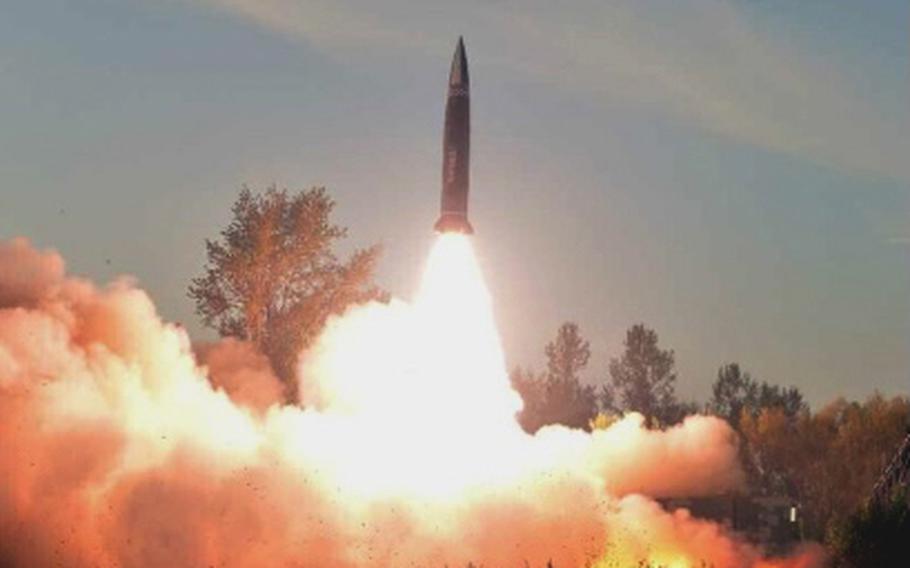
A North Korean missile takes flight in this undated photograph from the Korean Central News Agency. (KCNA)
North Korea fired an intercontinental ballistic missile Friday that came down in seas less than 150 miles from Japanese territory, according to the South Korean and Japanese militaries.
The North’s ICBM launched at 10:14 a.m. from a point near its western coast, according to a news release from the Japanese Ministry of Defense. No alert in Japan was issued since the missile was expected not to reach its territories, Japanese Defense Minister Yasukazu Hamada said at a news conference Friday.
The missile was estimated to have flown eastward for 69 minutes before splashing down in the East Sea, or Sea of Japan, 124 miles west of Oshima-Oshima, an island off the southwestern tip of Hokkaido, at 11:23 a.m., Hamada said. He said the missile landed within the country's exclusive economic zone but that no damages to aircraft or ships were reported.
Based on its trajectory and initial estimates, the missile has a potential range of 9,320 miles, which is within range of the continental United States, Hamada said.
South Korea’s Joint Chiefs of Staff also described the missile as an ICBM and that it was launched from the Sunan area of Pyongyang, site of the country’s international airport, according to a message to reporters. The Joint Chiefs estimated the missile flew roughly 620 miles at a peak altitude of around 3,790 miles.
“The South Korean military currently maintains full preparedness” and is closely consulting with the United States, the Joint Chiefs said.
The ICBM launch comes a day after North Korea launched a lone missile to the northeast. The communist regime fired a short-range missile eastward that did “not pose an immediate threat” to U.S. service members, territory or allies, according to a Thursday statement from U.S. Indo-Pacific Command.
In response to the launch, South Korean and U.S. fighters demonstrated together over the East Sea, the Joint Chiefs said in a Friday afternoon news release.
Four South Korean F-35A Lightning II stealth fighters and four U.S. Air Force F-16 Fighting Falcons flew in attack formation. According to the Joint Chiefs, an F-35A struck a simulated North Korean mobile missile launcher using a precision guided bomb at the Pilseung range in Gangwon province.
“Through this ... strike drill and joint attack squadron flight, South Korea and the U.S. demonstrated a strong will to respond firmly to any threats and provocations,” the news release said.
It’s not the first time this year that South Korea has responded to a perceived provocation from the North by scrambling jet fighters. South Korea last flew a contingent of about 80 military aircraft on Nov. 4 after tracking approximately 180 flights by North Korean warplanes inside North Korean territory.
A month earlier, after North Korea launched an intermediate range ballistic missile, four South Korean F-15K Slam Eagles and four U.S. F-16s dropped two Joint Direct Attack Munition, or JDAM, bombs on an island target in the Yellow Sea.
Thursday's short-range ballistic missile was fired shortly after North Korean Foreign Minister Choe Sun-hui warned of consequences to joint efforts by the U.S., Japan and South Korea to deter Pyongyang, according to her statement in the state-run Korean Central News Agency.
Choe’s statement repeated North Korea's assertion that joint military exercises between Seoul and Washington are "war drills for aggression."
North Korea last tested an ICBM on Nov. 3, which South Korean defense officials said ultimately failed during flight, according to a Yonhap News report the same day. North Korea’s launch on Friday marks its eighth ICBM since January.
North Korea has fired over 65 missiles in 33 days of testing so far this year. The unprecedented rate of testing has prompted President Joe Biden, South Korean President Yoon Suk Yeol and Japanese Prime Minister Fumio Kishida to pledge to work closely to deter North Korea.
“North Korea’s provocations, unprecedented both in their frequency and their manner, continue,” Kishida said alongside Biden and Yoon during a meeting in Cambodia on Sunday. “And we assume that there could be more coming.”
The three met on the sidelines of the Association of Southeast Asian Nations summit meeting in Phnom Penh.
Kishida added “it is extremely, truly timely that the Japan-U.S.-[South Korea] trilateral summit is being held at such a juncture” and that he hoped their “cooperation will be cemented further as we counter such challenges resolutely.”
National Security Council spokesperson Adrienne Watson described the latest North Korean missile launch as a "brazen violation of multiple U.N. Security Council resolutions and needlessly raises tensions and risks destabilizing the security situation in the region," according to a White House statement Friday.
The “door has not closed on diplomacy” for North Korea, Watson said, but it must stop “destabilizing actions and instead choose diplomatic engagement."
Also Friday, U.S. Vice President Kamala Harris called for an emergency meeting of five countries to address the ICBM launch. Representatives of Japan, South Korea, New Zealand, Australia, and Canada met during the Asia-Pacific Economic conference in Bangkok, according to a news release from the Japanese Foreign Ministry. They denounced Friday’s missile launch and agreed to work even more closely to denuclearize North Korea.